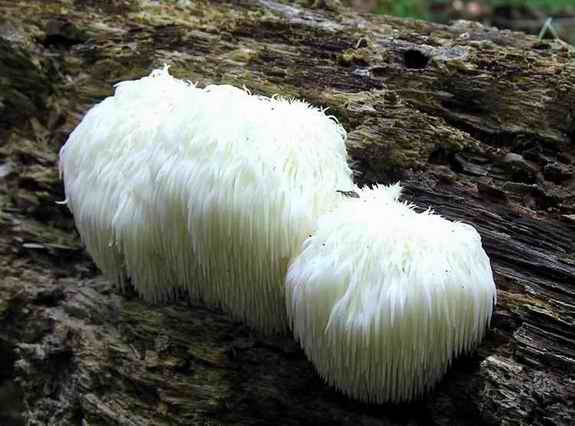|
Return to Hiker's Notebook Home Page
Common Name: Lion's Mane, Satyr's beard, Hedgehog mushroom, Bearded hedgehog, Bearded tooth, Old man's beard, Sheep's head, Bear's head, Unbranched hericium - The common names reflect the hirsute (hairy) or hircine (goat-like) appearance of the spines that comprise the spore-bearing surface of the fungus.
Scientific Name: Hericium erinaceus - The generic name is probably derived from either the Latin word hirtus, which means rough or shaggy, or the Latin word hircus, which means goat. The species name is the Latin word for hedgehog. Formerly known as Hydnum (from the Greek word hydnon meaning truffle) erinaceum and sometimes seen as Clavaria (from clavula meaning small club) erinaceus.
The Lion's Mane is a parasitic and saprophytic tooth fungus that grows on injured and fallen hardwood trees, most notably on oak logs and stumps but also on maple, sycamore, walnut and beech trees. It is readily identifiable, the only North American species that forms a single ball-like clump of white spines; its thin hair-like tendrils give it the appearance a sea anemone that has been neatly combed. Its many descriptive common names are alternative visual mnemonic associations. The hedgehog is a small insectivore (of the family Erinacceidae) native to Europe with a shaggy coat of sharp spines. The satyr is a minor woodland deity of Greek mythology with the legs of a goat and the torso and (normally bearded) head of a human.
Hericium erinaceus is lauded as a particularly desirable edible fungus in most field guides. It has been described as having the texture of sea foods such as octopus and squid with a flavor reminiscent of citrus scented flowers and an aroma that is mildly musky. However, the ambrosial descriptors really only apply when the fruiting body is young and fresh; like its namesake the satyr's beard, it sours with age. Contrary to the sententious aphorism that good tasting food is bad for you, the Lion's mane has significant nutritional attributes. It has 32 grams of protein for every 100 grams of dry weight, and has significant amounts of the minerals iron, phosphorus, calcium and potassium. It is also rich in the B vitamins thiamin, riboflavin, and niacin and the D vitamin precursor ergosterol. It is grown commercially and marketed as the pom-pom mushroom; hedgehog mushroom or satyr's beard are not conductive to notions of palatability.
The Lion's mane is the most recognizable the tooth fungi which were at one time all in one large family, the Hydnaceae. The classification of the fungi according to taxonomy was a more formidable challenge than the classification of plants (though at the time the fungi were considered plants of the Phylum Thallophyta) due to their greater diversity and variation. The tooth fungi were one of only four genera known in 1821 when the fungal classification was initiated by Elias Fries. The gilled fungi were Agaricus, the pore fungi Boletus and the coral fungi Clavaria. The tooth fungi of the genus Hydnum were taxonomically classified by their production of spores on the outer layer of the tooth-like spines. Since the initial classification, the tooth fungi have been reorganized so that there is at least one tooth fungi in each of 13 different families. Hericium erinaceous is in the family Hericiaceae, whose members have spiny amyloid spores.
Hericium erinaceus has been highly prized as an edible and medicinal fungus in China and Japan for centuries. In China, it is called houtou, which means monkey head mushroom, geographically appropriate for the indigenous Asian fauna. In Japan, it is known as yamabushi-take, which means the mushroom of the yamabushi, Japanese ascetics and priest-warriors who lived in the mountains. This name is likely a metaphor; the fungus is normally found growing as a single outgrowth in remote areas with old and dead wood, reminiscent of the solitary isolated yamabushi. The houtou was first domesticated at the Shanghai Agricultural Academy of Science in 1959 and has since spread globally. It is estimated that almost 10,000 metric tons were produced in 2001.
In traditional Asian medicine, the houtou or yamabushi-take was prescribed primarily for the treatment of stomach disorders. Trials conducted in China in the 1990's demonstrated that extracts of H. erinaceus reduced inflammation of the alimentary canal, lending credence to the practices of ancient fungal pharmacology. It is also used in China to increase the longevity of cancer patients. More recently, Japanese researchers patented the compound erinacines, which has been shown to stimulate the growth of neurons (known as Nerve Growth Stimulant Factor, or NGSF). This has inaugurated some interest in the use of the fungus in the treatment of Alzheimer's disease, strokes and other debilitating conditions associated with nerve damage. There is also some indication that other active constituents of the fungus may enhance the response of the immune system; a study of the effects of an extract called PHE (polysaccharide of H. erinaceus) on mice revealed that there was an increase in the production of lymphocytes. |
